Fast-paced running
Running is one of the most simple athletic endeavors humans can do, mainly because no equipment is needed—technically not even shoes (though our 21st-century living environment calls for them). Running at 8 mph burns 1,074 calories per hour for a 200-pound person, according to fitness expert Chris Ryan, CSCS, CPT, a New York City-based trainer. Because it requires a serious amount of energy to move fast and places a lot of demand on your cardiovascular system, most of us can’t sprint or run too fast for too long.
“The best way to incorporate this exercise is to do 10- to 20-second sprints (or 100–200 meters, if you’re on a track) and then jog or walk for 60 seconds,” says Roger E. Adams, PhD, Houston-based dietitian and nutritionist and founder of eatrightfitness.com. “Keep repeating these intervals until you’ve had enough, or until your sprints look like jogs.” Hoping to maximize your workout even more? Add a weighted vest to your sprints. This will drive up your calorie burn and is much safer than holding dumbbells or using ankle weights. If you’re a walker, but want to become a runner, check out these eight easy ways to make the speedy transition.
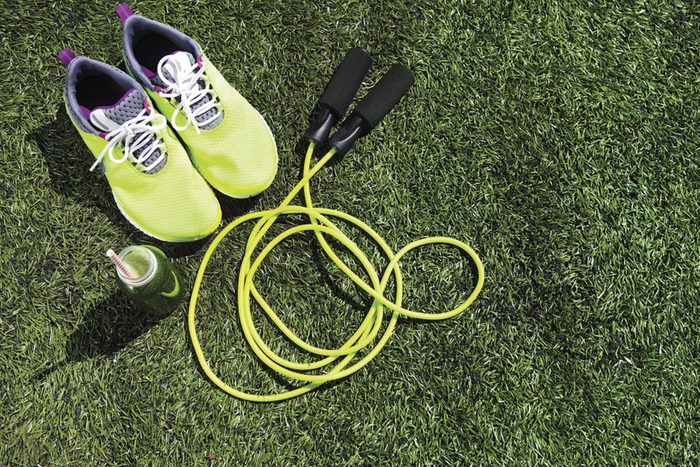
Jumping rope
There’s a reason some of the world’s greatest boxers have relied on the benefits of jumping rope to train their footwork and increase their heart rate. “Jumping rope can burn upwards of 1,074 calories per hour and is an excellent workout for the whole body,” says Ryan. “Even just a few minutes of jumping rope can get your lungs burning and heart racing.”
One of the best parts of this calorie-torching exercise? You can do it almost anywhere, anytime, though few of us can handle it for more than a few minutes straight. Just like running, “the best way to incorporate jumping rope into your exercise regimen is to do intervals,” says Dr. Adams. “Jump rope for a specified number of reps, say 100, then walk around or in place for 60 seconds. Then repeat this interval until you’re too tired to jump effectively.” If you can jump rope for several minutes straight, go for it! Otherwise, use the interval approach for maximum results. (Jumping rope vs. running: find out which is the better exercise.)
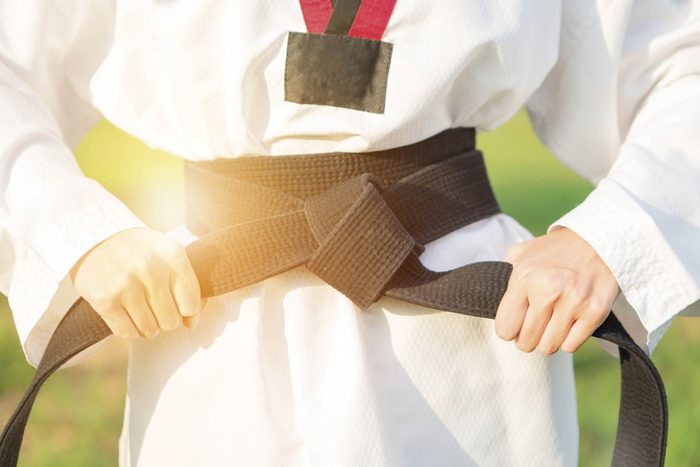
Taekwondo
When it comes to martial arts exercises that burn mega calories, Taekwondo takes the black belt, burning about 937 calories per hour for a 200-pound individual. Similar to wrestling or boxing, Taekwondo is a self-defense exercise that originated in Korea and has been around for about 2,000 years. Typically, you’d perform the exercise by competing against another person across from you. This person tries to weaken your technique and cause you to let your guard down. “The exercise emphasizes speed, power, concentration, reaction force, and breath control among its guiding principles, truly taking on an otherworldly athletic mindset and transforming mind and body to one powerful weapon,” says Ryan. However, many people rest quite a bit between movements, so in order to keep this mode of exercise at the top of the calorie-burning spectrum, minimize rest periods and go directly into each of your movements. Need a little self-confidence to try Taekwondo or push yourself harder? These nine science-backed tips will enhance your self-esteem.
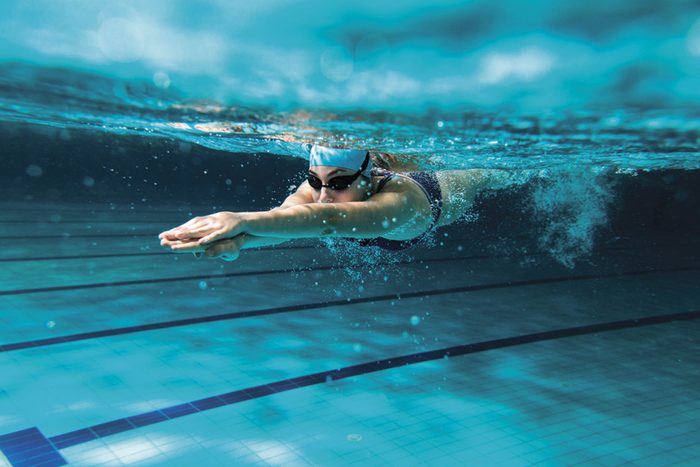
Vigorous swimming
You’ve probably heard that swimming, though low-impact and relatively accessible for nearly all individuals regardless of age or injury, burns serious calories—and that’s no lie. Vigorous, or high-intensity, swimming can burn upwards of 892 calories an hour for a 200-pound person. In addition to its therapeutic benefits and fine balance between strength and cardio, one of swimming’s ancillary benefits is simply being in water. “Your body normally runs at 98.6 degrees, but the average pool temperature is usually around 80 degrees—so your body burns calories just by trying to keep you warm and make up for the near 20-degree difference,” explains Ryan.
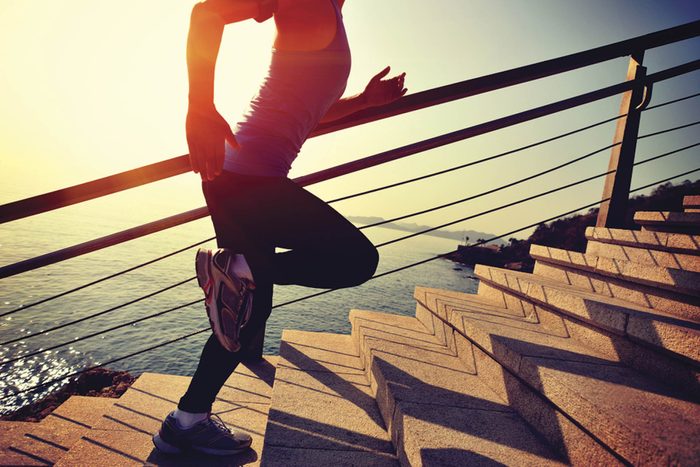
Running Up Stairs
Nothing quite puts the hussle in a hard-earned workout like running up a set of stairs. Not only is it great for muscle-building and improving your cardiovascular fitness level, but it’s also a serious calorie-scorcher. Running stairs can burn upwards of 819 calories per hour for a 200-pound person.
“Stair running essentially elevates the heart rate while the heart and lungs pump more blood and oxygen, resulting in a higher caloric burn than doing the same distance on flat ground,” explains Ryan. Your speed, number of steps, and the height of the steps will all factor in to determine your overall calorie burn. “Keeping a faster pace up the stairs and walking down is the safest approach,” says Samantha Clayton, vice president of sports performance and fitness at Herbalife. “You can vary your upward speed to increase the intensity level or if you have the coordination, taking two steps at a time will make your muscles work harder and therefore increase your calorie burn. The more steps you climb overall, the harder your body is working.” For more ways to keep burning calories, check out these 14 tips for jumpstarting your metabolism.
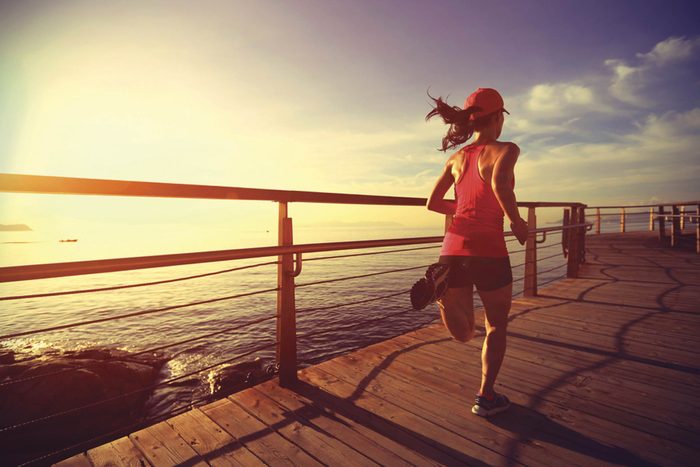
Jogging
Even at a relatively easy pace like 5 miles an hour, which is just above walking speed for most people, jogging is an excellent way to burn a high amount of calories. In fact, a 200-pound person can burn 755 calories per hour when running at this relaxed speed. Because it’s a full-body movement, running works many muscles at the same time and challenges your cardiovascular system. It’s also a fairly easy exercise to fit into people’s schedules because, most of the time, all it requires is some running shoes and pavement. “If you’re looking to add a little more caloric burn during your workout, try upping the incline a few percentages for short bouts of hills during your workout,” says Ryan. “This helps increase the intensity of the workout, but also shifts the position of the foot strike to mimic an undulating path or trail, which becomes a much more functional way to attack a workout.” Learn what happens to your body when you start a running regimen.
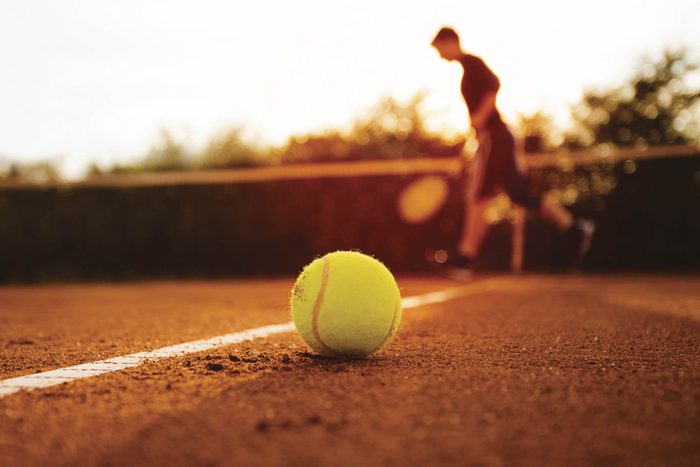
Tennis
Considered by many to be the ultimate form of “athletic chess,” tennis is an excellent way to burn serious calories. This is mainly because of the amount of fast-paced spurts of running and body movement required in a match. “What makes tennis so challenging is the rapid deceleration and acceleration that’s required for you to be good at the sport,” explains Ben Boudro, CSCS, owner of Xceleration Fitness in Auburn Hills, Michigan. “The ball movement is very unpredictable and when you have unpredictable requirements, you challenge your brain and muscles to contract as fast as possible to move your body and get in position.”
Playing tennis for just five minutes will put a serious tax on your body, and doing it for an hour could burn upwards of 728 calories for a 200-pound person. (You’ll burn less if you’re playing a doubles match.) “If you’re looking to get even more caloric burn from tennis, consider adding in lightweight compression shorts or a weighted vest,” suggests Ryan. “Working out with just 5–10 pounds of added weight can enhance your workout significantly.”
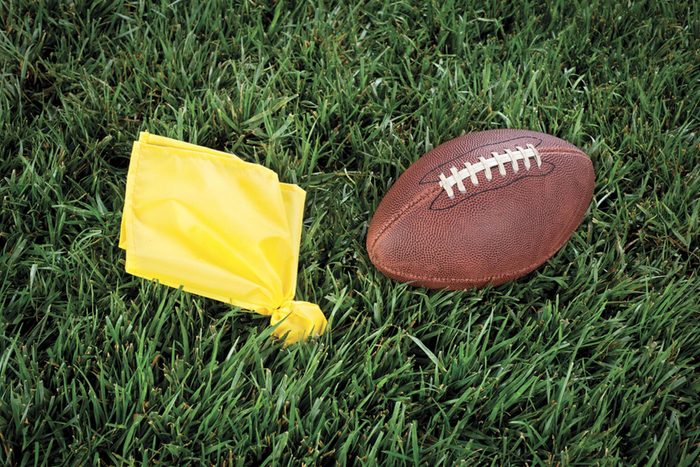
Flag football
Because it’s a common pick-up game that most people play recreationally, it’s easy to forget how great of a workout flag football can be. In fact, it can burn 728 or more calories an hour for a 200-pound person! The field may be shorter than regular football, but with fewer players in the game (and less hitting) most people run even more. “Coupled with a change of direction and hand-eye coordination, flag football truly combines a great way to have fun with friends during a whole body workout,” says Ryan. To up the workout ante a little more, opt to play receiver on offense or cornerback on defense, as these positions will leave your lungs gasping and body burning far more than playing quarterback or lineman. Ready to test your fitness level? See if you can pass these 10 everyday fitness tests.
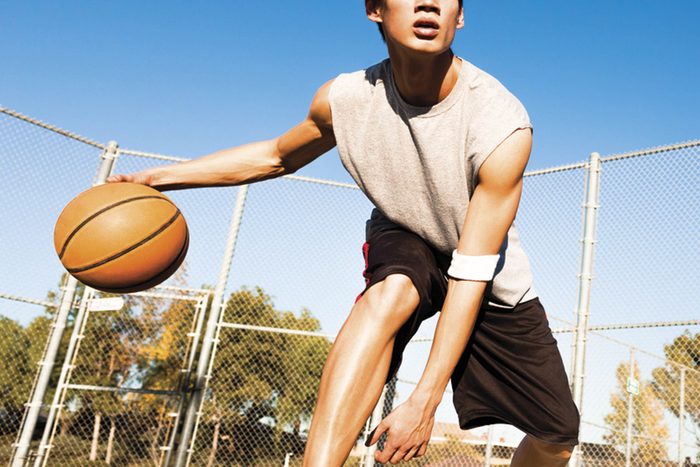
Basketball
If you want to be good at basketball, you better be able to move—and move often. The sport consists mainly of players running, with short bouts of sprints and all-out jumps from one side of the court to the other for an hour or longer, and with minimal breaks. “These all-out movements seriously tax your body and force you to use energy systems that are used in everyday activities,” explains Boudro. “Couple those movements with competition and a hot gym and you’re definitely going to be burning a ton of calories within minutes.”
Basketball is known to burn upwards of 728 calories an hour for a 200-pound person. Start off by playing for 15 minutes and build up your tolerance from there, Boudro suggests. Be careful with this one though, as too many injuries happen in the sport, often because individuals aren’t prepared for that kind of impact on their body. Start slow and work your way up, he says. Need motivation to get started? Try these 11 tricks to get moving again.

Rollerblading
Rollerblading combines a healthy balance of cardio and strength training, without placing too much impact on the joints. Similar to skating, rollerblading involves the use of quite a few muscles at once. “The data for a 200-pound person indicates that 683 calories per hour are burned at moderate intensity,” says Ryan. “But to engage the upper body even more, consider adding in some dry land ski poles, which in essence transforms this into a summer version of cross country skiing.” Also, adding in several short bursts of sprints for 10 to 20 seconds at a time are not only fun, but a great way to jack up your heart rate for an even higher calorie burn. It could be time for you to switch up your workout and try rollerblading! Here are seven signs you need a new go-to exercise routine.
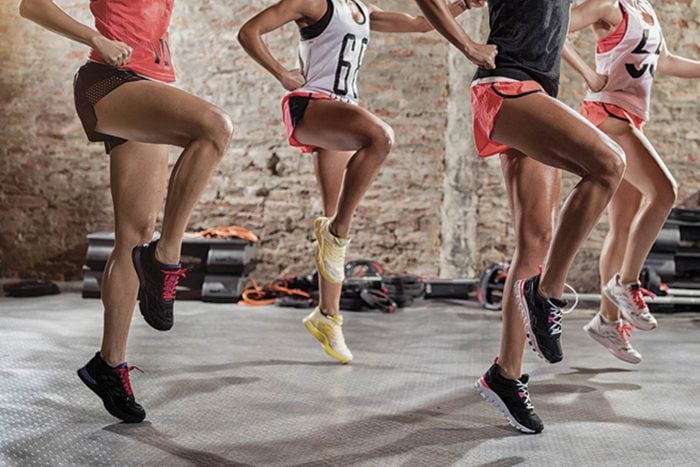
High-impact aerobics
Jane Fonda is proof that aerobics can be both fun and seriously beneficial when it comes to burning calories and toning muscle. “High-impact aerobic movements challenge your body and muscles to really contract and release in a fast, yet controlled, manner,” explains Boudro. The term high-impact refers to activities where both feet leave the ground, such as jumping jacks, plyometric style hopping movements, and some dance moves, among other exercises.
While this form of exercise is often fun and allows for a lot of variety, the impact on the joints is not for everyone. “This type of exercise can be made more intense by adding in weighted equipment, keeping the intensity level high and doing exercise that specifically works the large muscle groups such as the glutes, legs, chest, and back,” says Clayton. “This type of training done in a high-intensity interval training (HIIT) style, where you perform work-to-rest intervals, can increase the overall calorie burn dramatically. It’s important to note, however, that when working out at a high intensity, a shorter overall workout duration is important (ideally lasting 20 to 30 minutes).
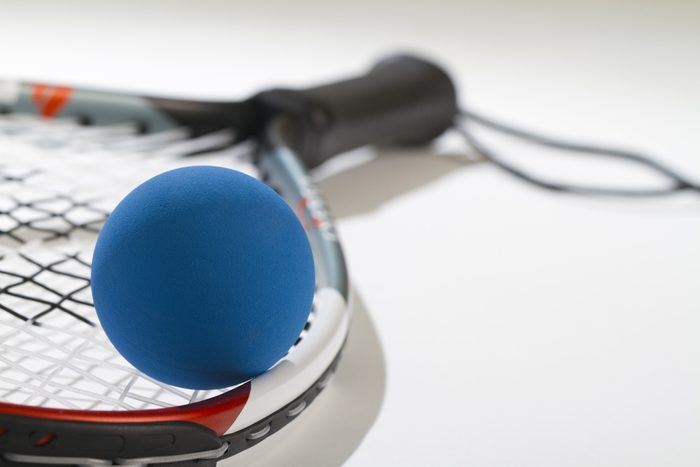
Racquetball
Similar to tennis, racquetball is a very intense form of exercise, burning upwards of 637 calories an hour for the average adult. “You might not think so because it’s mainly old guys playing this at the gym, but if you try it, you’ll notice instantly that it is very challenging. That’s mainly because you never sit down,” says Boudro. “With such a small court and a bouncy ball, you have to be constantly cutting, running, jumping, and lunging to get yourself in the position for the ball.” But perhaps the best part about this sport is how challenging it can be both mentally and physically. Get some buds and start by playing for 30 minutes. Still feel good? Play for one hour! If you need some ideas on how to make your workout even more fun, check out this list of tips for making exercise feel less like a chore.

Backpacking
Carrying a backpack on a hike or climb of any sort is a great form of outdoor exercise, burning around 637 calories for a 200-pound individual. Thanks to the added weight of the bag, you’re building muscular strength both in your upper and lower body. “The varied terrain is also great for improving coordination and working the small stabilizing muscle in the legs and ankles,” says Clayton. To make backpacking burn even more, consider increasing the weight you’re carrying or choosing an even steeper terrain.

Water skiing
This surface water sport, which involves balancing on two skis while being pulled by a boat, might look easy, but it’s actually a difficult skill. “Part of the workout is getting the position and really leaning back with your core as you press your feet into the water,” explains Boudro. “With your arms constantly contracting by pulling the rope, you’ll be working your forearms, biceps, and lats, as your quads and calves are simultaneously contracting.” Depending on whether or not you go with one ski or two skis, your quads and forearms will be on fire after just 30 seconds of waterskiing. To make this into a more intense workout, Boudro suggests setting up a course to run through or simply timing yourself and attempting six rounds at three minutes each, with constant carving in the water. Think you’re too old for activities like this? Think again! Here are 17 myths about fitness after 50.
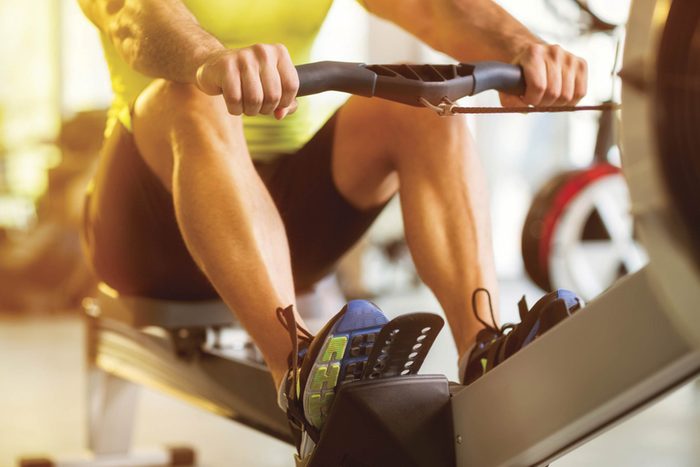
Rowing machine
While rowing machines may seem old school, they’re making a big comeback in gyms and studios across the U.S. “Rowing is a fantastic total-body exercise that’s low impact but burns a lot of calories with minimal impact on the joins,” says Clayton. “The rowing action uses both the lower and upper body, which is fantastic for burning calories at the same time as working multiple muscle groups.” As with most cardio exercises, in order to increase the calorie burn, you should do bouts of high-intensity work, mixed with periods of slower paced rowing. This is easy to do now that most rowing machines allow you to adjust your resistance. Clayton suggests doing 60 seconds of rowing at a high speed and 15 seconds at a slow speed. However, you can also do a moderate pace for many minutes straight, which is a strong steady-state exercise program. Now check out the best home rowing machines and how to choose one.

